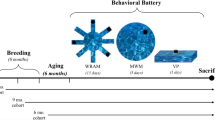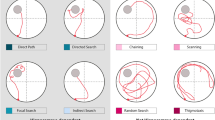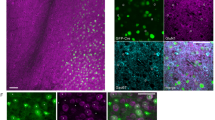Abstract
Gene-targeted mice lacking the AMPA receptor subunit GluR1 (GluR-A) have deficits in hippocampal CA3–CA1 long-term potentiation. We now report that they showed normal spatial reference learning and memory, both on the hidden platform watermaze task and on an appetitively motivated Y-maze task. In contrast, they showed a specific spatial working memory impairment during tests of non-matching to place on both the Y-maze and an elevated T-maze. In addition, successful watermaze and Y-maze reference memory performance depended on hippocampal function in both wild-type and mutant mice; bilateral hippocampal lesions profoundly impaired performance on both tasks, to a similar extent in both groups. These results suggest that different forms of hippocampus-dependent spatial memory involve different aspects of neural processing within the hippocampus.
This is a preview of subscription content, access via your institution
Access options
Subscribe to this journal
Receive 12 print issues and online access
$209.00 per year
only $17.42 per issue
Buy this article
- Purchase on Springer Link
- Instant access to full article PDF
Prices may be subject to local taxes which are calculated during checkout





Similar content being viewed by others
References
Bliss, T.V.P. & Lømo, T. Long-lasting potentiation of synaptic transmission in the dentate area of anaesthetized rabbit following stimulation of the perforant path. J. Physiol. (Lond.) 232, 331–356 (1973).
Bliss, T.V.P. & Collingridge, G.L. A synaptic model of memory: long-term potentiation in the hippocampus. Nature 361, 31–39 (1993).
Martin, S.J., Grimwood, P.D. & Morris, R.G.M. Synaptic plasticity and memory: an evaluation of the hypothesis. Annu. Rev. Neurosci. 23, 649–711 (2000).
Morris, R.G.M., Garrud, P., Rawlins, J.N.P. & O'Keefe, J. Place navigation impaired in rats with hippocampal lesions. Nature 297, 681–683 (1982).
Morris, R.G.M., Anderson, E., Lynch, G.S. & Baudry, M. Selective impairment of learning and blockade of long-term potentiation by an N-methyl-D-aspartate receptor antagonist, AP5. Nature 319, 774–776 (1986).
Bannerman, D.M., Good, M.A., Butcher, S.P., Ramsay, M. & Morris, R.G.M. Distinct components of spatial learning revealed by prior training and NMDA receptor blockade. Nature 378, 182–186 (1995).
Saucier, D. & Cain, D.P. Spatial learning without NMDA receptor-dependent long-term potentiation. Nature 378, 186–189 (1995).
Tsien, J.Z., Huerta, P.T. & Tonegawa, S. The essential role of hippocampal CA1 NMDA receptor-dependent synaptic plasticity in spatial memory. Cell 87, 1327–1338 (1996).
Tang, Y-P. et al. Genetic enhancement of learning and memory in mice. Nature 401, 63–69 (1999).
Chen, C. & Tonegawa, S. Molecular genetic analysis of synaptic plasticity, activity-dependent neural development, learning, and memory in the mammalian brain. Annu. Rev. Neurosci. 20, 157–184 (1997).
Zamanillo, D. et al. Importance of AMPA receptors for hippocampal synaptic plasticity but not for spatial learning. Science 284, 1805–1811 (1999).
Olton, D.S., Becker, J.T. & Handelmann, E. Hippocampus, space and memory. Behav. Brain Sci. 2, 313–366 (1979).
Rawlins, J.N.P. & Olton, D.S. The septohippocampal system and cognitive mapping. Behav. Brain Res. 5, 331–358 (1982).
Deacon, R.M.J., Bannerman, D.M., Kirby, B.P., Croucher, A. & Rawlins, J.N.P. The effects of cytotoxic hippocampal lesions in mice on a cognitive test battery. Behav. Brain Res. 133, 57–68 (2002).
Tonkiss, J. & Rawlins, J.N.P. The competitive NMDA antagonist, AP5, but not the non-competitive antagonist, MK-801, induces a delay-related impairment in spatial working memory in rats. Exp. Brain Res. 85, 349–358 (1991).
Steele, R.J. & Morris, R.G.M. Delay-dependent impairment of a matching-to-place task with chronic and intrahippocampal infusion of the NMDA antagonist D-AP5. Hippocampus 9, 118–136 (1999).
O'Keefe, J. & Nadel, L. The Hippocampus as a Cognitive Map (Oxford Univ. Press, 1978).
Morris, R.G.M., Schenk, F., Tweedie, F. & Jarrard, L.E. Ibotenate lesions of the hippocampus and/or subiculum: dissociating components of allocentric spatial learning. Eur. J. Neurosci. 2, 1016–1028 (1990).
Logue, S.F., Paylor, R. & Wehner, J.M. Hippocampal lesions cause learning deficits in inbred mice in the Morris water maze and conditioned fear task. Behav. Neurosci. 111, 104–113 (1997).
Bannerman, D.M. et al. Double dissociation of function within the hippocampus: a comparison of dorsal, ventral and complete hippocampal cytotoxic lesions. Behav. Neurosci. 113, 1170–1188 (1999).
Magee, J.C. & Johnston, D. A synaptically controlled, associative signal for Hebbian plasticity in hippocampal neurons. Science 275, 209–213 (1997).
Pike, F.G., Meredith, R.M., Olding, A.W. & Paulsen, O. Post-synaptic bursting is essential for 'Hebbian' induction of associative long-term potentiation at excitatory synapses in the rat hippocampus. J. Physiol. (Lond.) 518, 571–576 (1999).
Paulsen, O. & Sejnowski, T.J. Natural patterns of activity and long-term synaptic plasticity. Curr. Opin. Neurobiol. 10, 172–179 (2000).
Hoffman, D., Sprengel, R. & Sakmann, B. Molecular dissection of associative plasticity in CA1 hippocampal pyramidal neurons. Proc. Natl. Acad. Sci. USA 99, 7740–7745 (2002).
Morris, R.G.M. Spatial localisation does not depend on the presence of local cues. Learn. Motiv. 12, 239–269 (1981).
Morris, R.G.M. Development of a watermaze procedure for studying spatial learning in the rat. J. Neurosci. Methods 11, 47–60 (1984).
Acknowledgements
This work was supported by a European Union (E.U.) Framework V grant (QLG 3-CT-1999-01022). The authors would like to thank G. Daubney for assistance with the histology.
Author information
Authors and Affiliations
Corresponding author
Ethics declarations
Competing interests
The authors declare no competing financial interests.
Rights and permissions
About this article
Cite this article
Reisel, D., Bannerman, D., Schmitt, W. et al. Spatial memory dissociations in mice lacking GluR1. Nat Neurosci 5, 868–873 (2002). https://doi.org/10.1038/nn910
Received:
Accepted:
Published:
Issue Date:
DOI: https://doi.org/10.1038/nn910
This article is cited by
-
Distinct contributions of GluA1-containing AMPA receptors of different hippocampal subfields to salience processing, memory and impulse control
Translational Psychiatry (2022)
-
Metformin inhibits cardiometabolic syndrome associated cognitive deficits in high fat diet rats
Journal of Diabetes & Metabolic Disorders (2022)
-
Subarachnoid Hemorrhage Induces Sub-acute and Early Chronic Impairment in Learning and Memory in Mice
Translational Stroke Research (2022)
-
Sex differences in spatial learning and memory and hippocampal long-term potentiation at perforant pathway-dentate gyrus (PP-DG) synapses in Wistar rats
Behavioral and Brain Functions (2021)
-
Apparatus design and behavioural testing protocol for the evaluation of spatial working memory in mice through the spontaneous alternation T-maze
Scientific Reports (2021)



